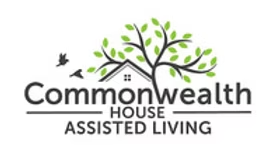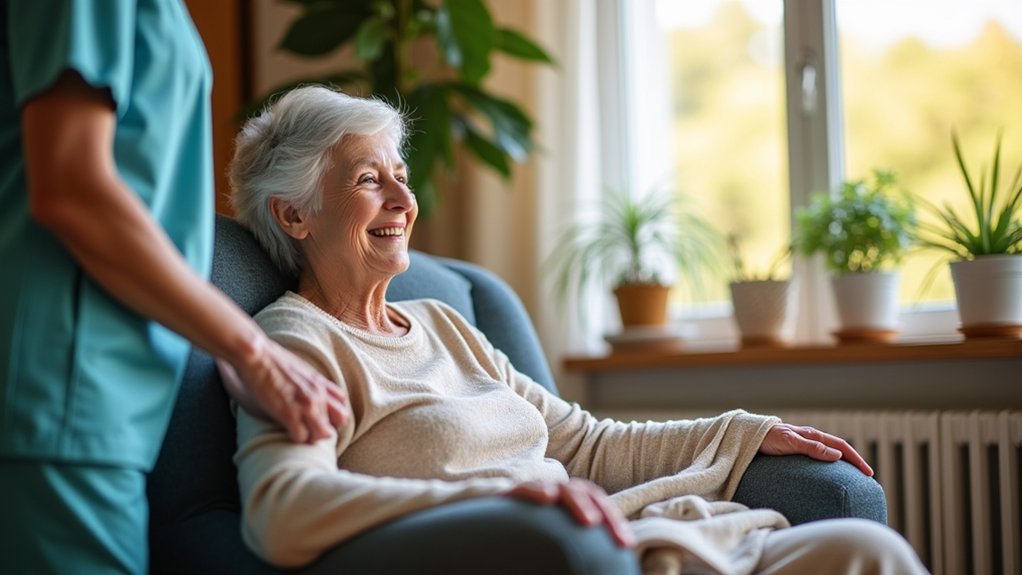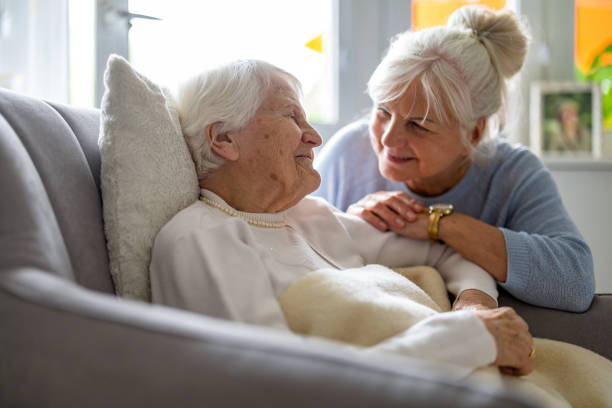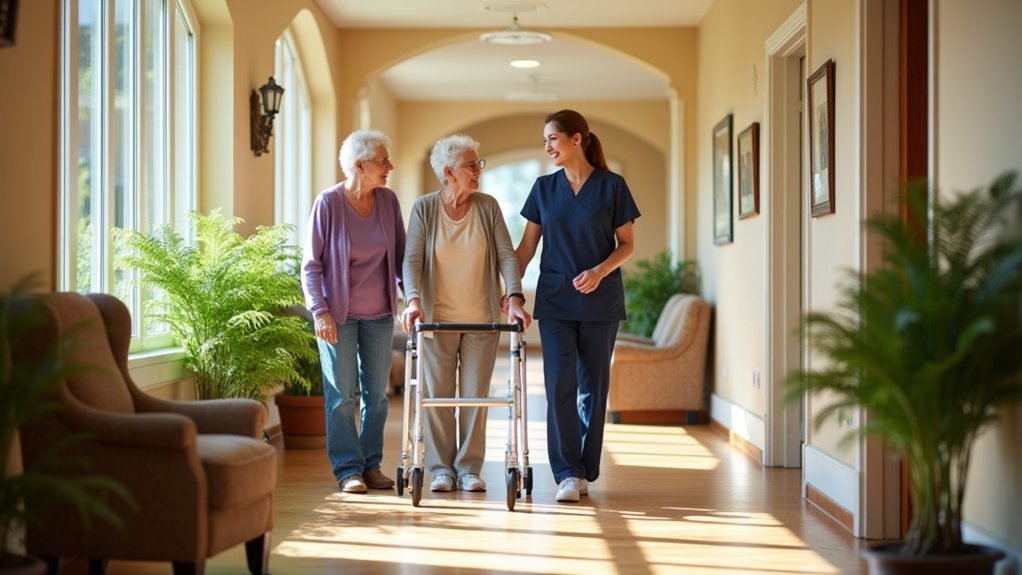You’ll be glad to know that assisted living facilities prioritize your safety by preventing falls and injuries with tailored measures. They design safe spaces with grab bars, non-slip surfaces, and clear pathways to keep you steady. Emergency response systems guarantee quick help when you need it, while trained staff monitor risks and create personalized care plans. They also encourage mobility with supportive tools. Stick around to uncover more ways they protect you!
Key Takeaways
- Assisted living facilities install non-slip flooring and grab bars to minimize fall risks in high-risk areas.
- Emergency response systems, like wearable devices, ensure quick help during falls or injuries.
- Staff training in fall prevention helps identify risks and assist residents with mobility.
- Personalized care plans address individual health needs to reduce fall likelihood.
- Regular safety checks and environmental modifications enhance overall resident safety.
Understanding the Risks of Falls in Senior Living
As you navigate the challenges of senior living, it’s essential to recognize that falls are a leading cause of injury among older adults. You’re in a position to make a difference by understanding these risks and taking proactive steps.
Whether you’re searching for “assisted living near me” or exploring options like senior living Warwick RI, knowing the hazards can guide your choices in protecting those you care for.
Falls often result from mobility issues, poor vision, or medication side effects. You can help by staying vigilant and advocating for safety in environments like senior care Warwick RI. Commonwealth House offers personalized care tailored to individual needs, which can significantly reduce the risk of falls.
Empower yourself to support loved ones by learning about fall risks and ensuring their surroundings promote well-being and security every day.
Designing Safe Spaces With Protective Features
Let’s focus on creating safer environments for seniors by designing spaces with protective features. As someone dedicated to serving others, you can make a difference by guaranteeing assisted living in Warwick, RI, prioritizes safety.
Install grab bars in bathrooms and hallways to provide steady support. Widen doorways to accommodate mobility aids, reducing the risk of bumps or stumbles. Ascertain adequate lighting in every room to help seniors see hazards clearly.
At facilities like assisted living Warwick, RI, you’ll find thoughtful layouts with rounded corners on furniture to minimize injury risks. Remove clutter and secure rugs to keep pathways clear. Additionally, the community environment fosters strong relationships among residents and staff, enhancing overall safety and well-being.
Implementing Non-Slip Surfaces for Stability
While designing safe spaces is essential, you can further enhance senior safety by implementing non-slip surfaces for stability.
As someone dedicated to serving others, you understand the importance of preventing falls in assisted living. Install non-slip flooring in high-risk areas like bathrooms, kitchens, and hallways. These surfaces provide better traction, reducing the chance of slips on wet or polished floors.
You can also add non-slip mats or tapes on stairs and ramps to guarantee seniors move confidently. Additionally, incorporating simple morning stretches can help improve balance and mobility, further reducing the risk of falls.
Regularly inspect these surfaces for wear and tear, replacing them as needed. By prioritizing stability, you’re creating a secure environment where seniors can thrive.
Your commitment to their well-being shines through in these thoughtful, practical measures for safety.
Providing Emergency Response Systems for Quick Help
Beyond ensuring stable surfaces, you can boost senior safety by providing emergency response systems for quick help.
As someone dedicated to serving others, you understand the importance of immediate assistance during a fall or injury. Equip seniors with wearable devices or easy-to-reach call buttons in their living spaces.
These tools connect them directly to help, ensuring they’re never alone in a crisis. Place systems in bedrooms, bathrooms, and common areas for full coverage.
Regularly test these devices to guarantee they work when needed. By prioritizing such technology, you’re giving seniors peace of mind and the confidence to move freely, knowing help is just a button away. Furthermore, integrating this technology with medication management services enhances the overall safety and well-being of seniors in assisted living.
Your commitment to their safety truly makes a difference.
Training Staff to Handle Critical Situations
As you focus on senior safety, training staff to handle critical situations becomes an essential step. You want to guarantee that every team member is ready to act swiftly when a fall or injury occurs. Equip them with hands-on skills to assess emergencies, provide first aid, and communicate effectively with medical professionals.
You’ll see the difference when staff confidently manage high-stress moments, offering reassurance to residents and families. In addition, fostering family involvement in the care process can enhance the overall safety and well-being of residents.
Encourage ongoing education to keep their knowledge fresh and relevant. Simulate real-life scenarios so they’re prepared for anything.
Creating Personalized Care Plans for Individual Needs
Since every senior has unique needs, creating personalized care plans is crucial for effective fall prevention in assisted living. You play a significant role in this process by evaluating each resident’s health history, physical abilities, and specific risks.
By collaborating with medical professionals and families, you’ll craft tailored strategies that address individual challenges, ensuring safety and dignity. The support of a favorable resident-to-staff ratio enhances the implementation of these personalized care plans, allowing for more focused attention on each resident’s needs.
As you implement these plans, focus on consistent monitoring and open communication. Adjust care as needs evolve, whether it’s modifying daily routines or enhancing supervision during high-risk times.
Your dedication to understanding each senior’s story fosters trust and empowers them to live confidently. Through your compassionate efforts, you’re not just preventing falls—you’re uplifting lives with personalized, heartfelt care.
Encouraging Mobility With Supportive Tools
While maintaining safety is key, you can also boost seniors’ confidence by encouraging mobility with supportive tools. As someone dedicated to serving others, you’ll find that providing the right equipment, like walkers or canes, empowers residents to move independently while reducing fall risks.
Make certain these tools are adjusted to fit each individual’s height and strength for maximum comfort.
You can also introduce grab bars in bathrooms and hallways to offer steady support. Encourage participation in guided exercise programs to build strength and balance, always staying close to assist. Additionally, proper nutrition plays a crucial role in maintaining muscle mass and overall health, further supporting mobility and reducing the risk of falls.
Monitoring Health to Prevent Potential Hazards
Let’s shift focus to keeping a close watch on seniors’ health to spot potential risks before they become problems.
As someone dedicated to serving others, you understand that regular health monitoring in assisted living can prevent falls and injuries.
You’re checking essential signs, tracking medication side effects, and noticing changes in behavior or mobility that might signal a hazard. Additionally, it’s important to collaborate with staff to create personalized care plans that address individual health needs and reduce the risk of falls.
Frequently Asked Questions
How Do Families Choose the Right Assisted Living Facility?
When choosing the right assisted living facility, you’ve gotta start by evaluating your loved one’s needs.
Look at their health, mobility, and personal interests. Visit multiple places, ask questions, and observe the staff’s care.
Check reviews and talk to other families. Guarantee the environment feels like home and aligns with your desire to serve them well.
Trust your instincts—you’re making a difference in their life every day.
What Are the Costs of Assisted Living Services?
Wondering about the costs of assisted living services?
You’re making a caring choice by exploring this for a loved one. Costs vary widely based on location, amenities, and care level, typically ranging from $3,000 to $8,000 monthly.
Don’t hesitate to ask facilities for detailed pricing and what’s included. Compare options, and guarantee you’re budgeting for extras like medical care.
You’ve got this—supporting their needs starts with informed decisions!
How Are Residents’ Dietary Needs Accommodated?
Hey, you’re curious about how residents’ dietary needs are met, and that’s a great question!
You’ll find that assisted living communities prioritize personalized care. They’ll assess your loved one’s specific nutritional requirements, allergies, and preferences.
Then, they’ll craft tailored meal plans, ensuring balanced, delicious options. You can help by communicating needs clearly, and they’ll work with you to keep residents healthy and happy through thoughtful, customized dining experiences every day.
What Social Activities Are Offered to Residents?
Hey, you’re curious about what social activities are offered to residents, right? Immerse yourself and discover a world of connection!
You’ll organize group games, crafts, and movie nights that bring smiles. Host book clubs or music sessions to spark joy and camaraderie.
Plan outings to local spots, ensuring everyone feels included. You’re not just planning events; you’re building a vibrant community where residents thrive through meaningful friendships and fun!
How Is Mental Health Support Provided?
Hey, you’re curious about how mental health support is provided, right?
Immerse yourself in a caring role by understanding that you’ll offer residents access to professional counselors who listen and guide.
You can encourage participation in group therapy sessions that build connection.
Don’t forget, you’re there to spot signs of distress and connect them with tailored resources.
Your empathy guarantees they’re never alone in their struggles, fostering true well-being every day.





